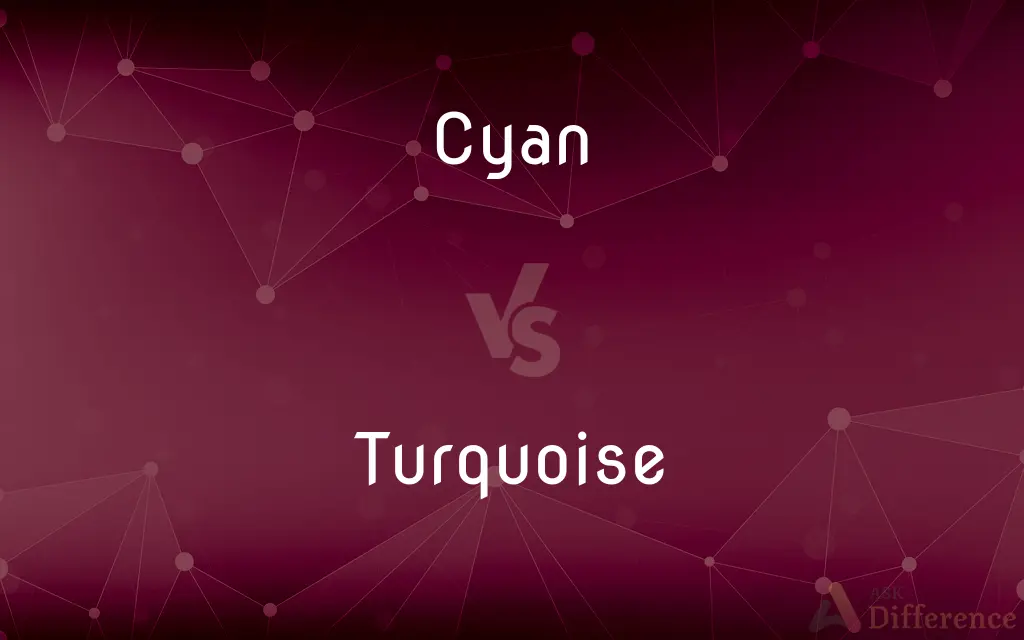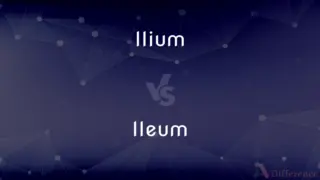Cyan vs. Turquoise — What's the Difference?
By Tayyaba Rehman & Fiza Rafique — Updated on September 9, 2023
Cyan is a greenish-blue color that is one of the primary colors in the subtractive CMY color model, while turquoise is a blue-green color often associated with the gemstone of the same name. Both are shades of blue-green but differ in their specific hue.

Difference Between Cyan and Turquoise
Table of Contents
ADVERTISEMENT
Key Differences
Cyan is a fundamental color in both the additive RGB color model used in digital displays and the subtractive CMYK model used in printing. It has a greenish-blue hue and serves as one of the primary colors in many color models. Turquoise, on the other hand, is more culturally and historically defined, often associated with the gemstone from which it takes its name. It is also a blue-green color but leans more towards blue than green.
Cyan is frequently employed in technical contexts. For instance, it is used in printing to achieve a wide range of colors when combined with magenta, yellow, and black. Turquoise doesn't have the same foundational role in color theory as cyan; it is more often found in decorative and artistic contexts, such as jewelry and interior design.
In digital settings, cyan is usually specified using numerical values across different color models like RGB or HEX. Turquoise doesn’t have a standard numerical value across platforms, which can result in variations in its appearance. Both colors are popular in graphic design but for different purposes. Cyan is often used for its high visibility and readability, while turquoise is commonly used for its aesthetic appeal.
Both cyan and turquoise have psychological and cultural meanings attached to them. Cyan is often associated with feelings of calmness and clarity. Turquoise has been historically associated with qualities like healing and protection, particularly in the form of the turquoise gemstone. Although both colors are visually similar, their functional applications and connotations differ significantly.
Comparison Chart
Color Model
Foundational in RGB and CMYK models
Not foundational in any color model
ADVERTISEMENT
Hue
Greenish-blue
Blue-green
Technical Uses
Printing, digital displays
Decorative, artistic
Standardization
Standard numerical values
Varies across platforms
Cultural Meaning
Calmness, clarity
Healing, protection
Compare with Definitions
Cyan
A primary color in the subtractive CMY color model.
Cyan ink is used in color printers.
Turquoise
A blue-green color often linked to the gemstone.
Her ring featured a stunning turquoise stone.
Cyan
A greenish-blue color.
The ocean appeared a beautiful shade of cyan.
Turquoise
A color more towards blue than green.
The sky was an impressive shade of turquoise.
Cyan
A foundational color in digital RGB displays.
Cyan is essential for rendering accurate colors on your screen.
Turquoise
A color frequently used in decorative arts.
We used turquoise accents to embellish the room.
Cyan
A color often associated with calmness and clarity.
The room was painted cyan to create a peaceful atmosphere.
Turquoise
A color without a standardized numerical value.
The turquoise hues varied from vendor to vendor.
Cyan
A color used in technical applications like printing.
We ran out of cyan ink during the large print job.
Turquoise
Historically associated with healing and protection.
The turquoise amulet was said to ward off evil spirits.
Cyan
Cyan () is the color between green and blue on the visible spectrum of light. It is evoked by light with a predominant wavelength between 490 and 520 nm, between the wavelengths of green and blue.In the subtractive color system, or CMYK color model, which can be overlaid to produce all colors in paint and color printing, cyan is one of the primary colors, along with magenta and yellow.
Turquoise
Turquoise is an opaque, blue-to-green mineral that is a hydrated phosphate of copper and aluminium, with the chemical formula CuAl6(PO4)4(OH)8·4H2O. It is rare and valuable in finer grades and has been prized as a gemstone and ornamental stone for thousands of years owing to its unique hue. Like most other opaque gems, turquoise has been devalued by the introduction onto the market of treatments, imitations and synthetics.
Cyan
A greenish-blue colour which is one of the primary subtractive colours, complementary to red.
Turquoise
A greenish-blue colour
The turquoise waters of the bay
Cyan
A greenish blue, one of the subtractive primary colors.
Turquoise
A semi-precious stone, typically opaque and of a greenish-blue or sky-blue colour, consisting of a hydrated phosphate of copper and aluminium.
Cyan
A vibrant pale greenish-blue colour between blue and green in the visible spectrum; the complementary colour of red; the colour obtained by subtracting red from white light.
Turquoise
A blue to blue-green mineral of aluminum and copper, mainly CuAl6(PO4)4(OH)8·4H2O, prized as a gemstone in its polished blue form.
Cyan
Of the colour cyan.
Turquoise
A light to brilliant bluish green.
Cyan
A blue-green that is one of the primary pigments
Turquoise
(countable) A sky-blue, greenish-blue, or greenish-gray semi-precious gemstone.
Cyan
A bluish shade of green
Turquoise
A pale greenish-blue colour, like that of the gemstone.
Turquoise
Made of turquoise (the gemstone).
Turquoise
Having a pale greenish-blue colour.
Turquoise
A hydrous phosphate of alumina containing a little copper; calaite. It has a blue, or bluish green, color, and usually occurs in reniform masses with a botryoidal surface.
Turquoise
Having a fine light blue color, like that of choice mineral turquoise.
Turquoise
A blue to gray green mineral consisting of copper aluminum phosphate; blue turquoise is valued as a gemstone
Turquoise
A shade of blue tinged with green
Common Curiosities
Is Cyan a primary color?
Yes, cyan is a primary color in the CMY and RGB color models.
Where is Cyan commonly used?
Cyan is commonly used in technical applications like printing.
What is Turquoise?
Turquoise is a blue-green color often linked to the gemstone of the same name.
Does Cyan have a standardized value?
Yes, cyan has standardized numerical values in various color models.
Is Cyan more green or blue?
Cyan is a greenish-blue color.
Where is Turquoise commonly used?
Turquoise is often used in decorative arts and jewelry.
What is Cyan?
Cyan is a greenish-blue color that is a primary color in many color models.
Does Turquoise have a standardized value?
No, turquoise does not have a standardized numerical value.
Is Turquoise a primary color?
No, turquoise is not considered a primary color in any color model.
Is Turquoise more green or blue?
Turquoise is more blue-green, leaning towards blue.
Do both colors have cultural meanings?
Yes, both colors have various cultural and psychological meanings.
What is the psychological impact of Turquoise?
Turquoise is historically associated with healing and protection.
What is the psychological impact of Cyan?
Cyan is often associated with calmness and clarity.
Is Turquoise used in digital displays?
Turquoise can be displayed but is not foundational in digital color models.
Is Cyan used in digital displays?
Yes, cyan is crucial for accurate color rendering in digital displays.
Share Your Discovery

Previous Comparison
Ilium vs. Ileum
Next Comparison
Impel vs. CompelAuthor Spotlight
Written by
Tayyaba RehmanTayyaba Rehman is a distinguished writer, currently serving as a primary contributor to askdifference.com. As a researcher in semantics and etymology, Tayyaba's passion for the complexity of languages and their distinctions has found a perfect home on the platform. Tayyaba delves into the intricacies of language, distinguishing between commonly confused words and phrases, thereby providing clarity for readers worldwide.
Co-written by
Fiza RafiqueFiza Rafique is a skilled content writer at AskDifference.com, where she meticulously refines and enhances written pieces. Drawing from her vast editorial expertise, Fiza ensures clarity, accuracy, and precision in every article. Passionate about language, she continually seeks to elevate the quality of content for readers worldwide.














































